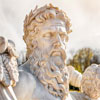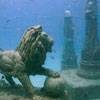Atlantean History – Part V
 By Yolen, Scribe of Atlantis
By Yolen, Scribe of Atlantis
Notes on Atlantean History during the Reign of Emperor Atlas:
The City of Paradise cont.
After leaving the Grove the visitor is invited to refresh himself in the Guest House, which is maintained for the entertainment of strangers. It stands between the Grove and the Gardens, which form the entrance to the Seven Gardens of Eden—the vast Gardens belonging to the imperial palace.
The Guest House, with its environing park, its pergolas, its walks and seats, its fountains and bird baths, its gorgeous flowers and shade trees, presents a picture impossible to describe. The building itself is of white marble, trimmed with green onyx and black Liberian stone. Within, the floors are of white marble, also trimmed in green and black. The woodwork of arches and windows is of cypress and olive, the relieving strips being of black oak. This building, as well as most public edifices in the City, is planned to stand square to the four points of the compass—facing North, South, East and West.
(I will add, here, that in all cities and larger towns of the empire similar Guest Houses are maintained at the cost of the Government.)
From the canopied roof of the House one can view the entire City of Paradise, with its wide avenues starting from the Grove of Neptune and radiating like the rays of the sun to the outermost limits of the Capital City. Glimpses of the remarkable Gardens of Eden, with the dazzling palace surmounting them, proves too great a temptation to be resisted by visitors to our city.
Consequently the strangers secure a guide and start on their visit to the Gardens and the majestic structure topping them.
The ravine which divides the Gardens from the City has been wisely landscaped, thus enhancing its natural beauty. Wherever an Avenue terminates in the Divide Gardens, an exquisite white marble bridge spans the ravine, thus connecting the Gardens of Eden with the City.
Crossing the Bridge back of the Guest House, the visitor follows the guide to the seven Gardens of Eden, starting at the first and lowest one. From this lowest one, and the largest in circumference, the ground rises gradually, until the Seventh Garden is reached. From here there is a cone-shaped hill upon the summit of which is the palace. Because of this prominence, the knoll capping the Seven Gardens has been given the name of the “High Hill.”
Each of the Seven Gardens of Eden is separated by canals of sparkling water. The supply of ever running water issues from a great fountain in the imperial park of the palace. From this fountain the waters pour down in cascades over opalescent glass bottoms, at four sides of the park, serving to refresh the flora and fauna that require drink, as well as to add beauty to the general scene of loveliness. The colorful glass under the cascades creates marvelous reflections through the falling waters, and flashes in the sunlight like the gleams of so many points of a diamond.
The four cascades feed the Seventh Canal below; but this stream empties itself by means of eight cascades into the next Canal lower down—the Sixth Canal of the Sixth Garden. So on down, the number of cascades double each time, until the waters fall into the broad and last Canal of the First Garden of Eden. Thence it is carried by way of artistic streams, or in underground conduits, to all parts of the city, to provide moisture for plants, and to furnish necessary water to keep the avenues and parks and public places clean.
Besides the lovely winding walks through the Gardens, and the bridges that span the Canals, there are escalators ascending—and descending—at the four sides of the imperial grounds. These end at the bottom of the High Hill, which one must climb one’s self, or in a motor. In the Seventh Garden, which surrounds the park of the palace, is a landing place for airships, or for individual Bird-Wings.
Arriving at the top of the High Hill the visitor gazes in rapt silence at the beauty and grandeur of the great building before him. A marvelous dome rises from the center of the roof of the palace, which the guide explains, is the top of the Temple, of the Law of One, in which the Government Circles meditate and receive Visions and hear the Voice to rule the empire. This bright and dazzling dome is always sending forth powerful beams of light. At night they act as beacons to mariners at sea, or as a guide to pedestrians in the Capital city. For centuries this lighted dome has never failed to send forth its rays. From this ‘radiant seat of Light’ down to the foundations of the palace are evidences of art and beauty, and all has been planned carefully to add to the natural effect of the place.
Since time immemorial Atlantis has been famous for her love and knowledge of symbolism. Here in the High Hill, in the palace, and in the Temple on top of the palace, it is wisely expressed. The very number of Gardens and Canals called ‘Eden,’ leading up to the High Hill, is symbolic. Again the highest point of land for miles around the Capitol, was selected ages ago for the site where the ruling of the government would meet and issue commands. The shining dome of the Temple signifies the ever-shining Light within; it also symbolizes the sun in the heavens. This dome is roofed with chrystalyn, but the inner ceiling is composed of Irigold, which shines brightly upon the interior of the auditorium. The calm shining of the moon is represented by the silvery reflections of four great arc lights placed at the four corners of the base of the dome. The stars are symbolized by the numerous lights shining and reflecting from the cornice of the roof of the palace.
The interior of the Temple, which is the richest and most perfect of its type in the world, is ornamented with precious metals and mosaics, and set with rare gems of ancient times. The walls are tapestried with valuable hangings which depict scenes of days of the period before the Third Deluge, and before that. They are so fine and so old that they are protected by chrystalyn, to prevent injury of any kind. The trim and seats in the auditorium are of carved bloodwood. The draperies and cushions are of artistic textiles which blend perfectly with the rich crimson of the wood, the shadowy effects made by the numerous arches opening to the chambers surrounding the assembly hall, and the bright points of light penetrating the painted windows.
The impressive Tablet standing upon a pedestal to remind the audience that the Law of One presides over all, and the reading desk upon a platform, where the Books of the Old Masters and Sages of Atlantis are read aloud when necessary, are the only objects visible for the worship or instruction of those who come there to meditate.
Perhaps this is the place to mention that, again and again, have the pagans sought to rob this mine of riches, of its rare jewels, its tapestries, its exquisite carvings and mosaics, but not one has succeeded. A secret system of electricity is installed throughout the Temple; so sensitive is the apparatus controlling this system that a marauding hand coming in contact with the protectors forms a circuit by which death is dealt to the trespasser.
The imperial palace likewise is decorated without regard to cost or labor. The entire roof covering the palace building forms a promenade and garden. It is floored with beautiful tile, and the groups of statuary and palms give the necessary touch of Nature. From this terrace a wonderful view, not only of the Seven Gardens of Eden with their paths, arbors, canals, flora and fauna, but the entire City, and for miles beyond, may be had.
The architecture of the public—and many private buildings—of Atlantis became a general favorite style the world over, and has been named ‘The Four-Square’ type. Hence the City of Paradise has become known as ‘The City Four-Square,’ because of its numerous four-square edifices.
The water feeding the great fountain on top of the High Hill comes from a distant reservoir constructed by engineers of ancient days. Throughout the past centuries Atlantean engineers were famous, and produced feats which staggered the rest of the world. The great pumping and piping system built and operated without trouble all down the centuries has been copied by other great cities. The famous lake of Moeris, 450 miles in circumference and 350 feet deep, with its subterranean channels, its floodgates, locks and dams, also the canals that lead from this vast storage house of waters of the Nile, to provide moisture which causes the desert to blossom like a garden, was a feat easily accomplished by scientific Atlanteans. Karnak, the marvels of the Labyrinth with its three thousand chambers and its courts, peristyles, pyramids and ornamentation, gave Egypt the fame it craved, but it is due to our architects and engineers that such fame was possible. Memphis with its monster embankments which divert the waters of the Nile from their usual course, is another bit of Atlantean ingenuity.
Deep in the great hollow back of the City stands the Mart. Its enclosing walls are so high and so wide that they provide space on top for a promenade. Large tubs of shrubs and flowering plants form a screen for the parapet on both sides of the walk. Here and there are stone benches for those who would like to rest. The ever-busy scenes in the mart provide constant amusement and interest for visitors upon the Wall. Because of an audience generally to be seen watching them, the workers below vie with each other in maintaining a high degree of order and cleanliness, besides the artistic display of their wares.
Laws regarding debris, odors and other unsightly conditions, so prevalent in other large cities in the world, are very strict in the Capital. Therefore no garbage, trash, or filth is to be found in the avenues or public places. The underground tunnels providing shuttles for traffic to and from the Mart and the water front, does away with noise and sights created by commercial work.
Beyond the Mart stretches the Plains. Here are located the great institutions which produce valuable products for Atlantis and the world. Also the plants which furnish the storage of heat and cold to the City of Paradise, and other public service are to be found here. Every important building has a grove surrounding it, and this gives an air of beauty and natural grace to the country.
Miles beyond the Plains rise the Seven Hills, with their beautiful villas and country homes. The Seven Hills encircle Paradise on three sides, and reach to the very waters of the Gulf. They actually provide a wall of defense for the Capital, since there is no other method of entering the City, unless one comes by way of the Gulf, which is always on the defensive in these later times.
From the summits of the Seven Hills one can see the far-off ranges of mountains, with snow-clad peaks, whence come our cold-storage air. These ranges, known as the Divide, really divide the Provence of Paradise from the other Provinces of the Continent Isle.
Our Atlantean engineers place their symbolic sign of the mystical Light, of the Law of One, upon every important work completed by them. This is done to inform the world, and the on-coming ages, of the wonders possible to achieve, when one understands the correct way to commune with the One. Because of this widely distributed symbolism upon famous works, peoples of other lands have come to appreciate the Truth found in the law. Everywhere in the empire, and in the subsidiary countries of Afro-Atla, Yucuyn, Incas, Aztecs, and others, there are many today who quietly follow the Light forever radiating from the Inner Shrine of every individual on earth.
Excerpt from The Prince of Atlantis by Lillian Elizabeth Roy
Part VI coming soon.
For the other parts to this series, see here.
Posted in Atlantean History, Atlantis, True History of Manwith comments disabled.





